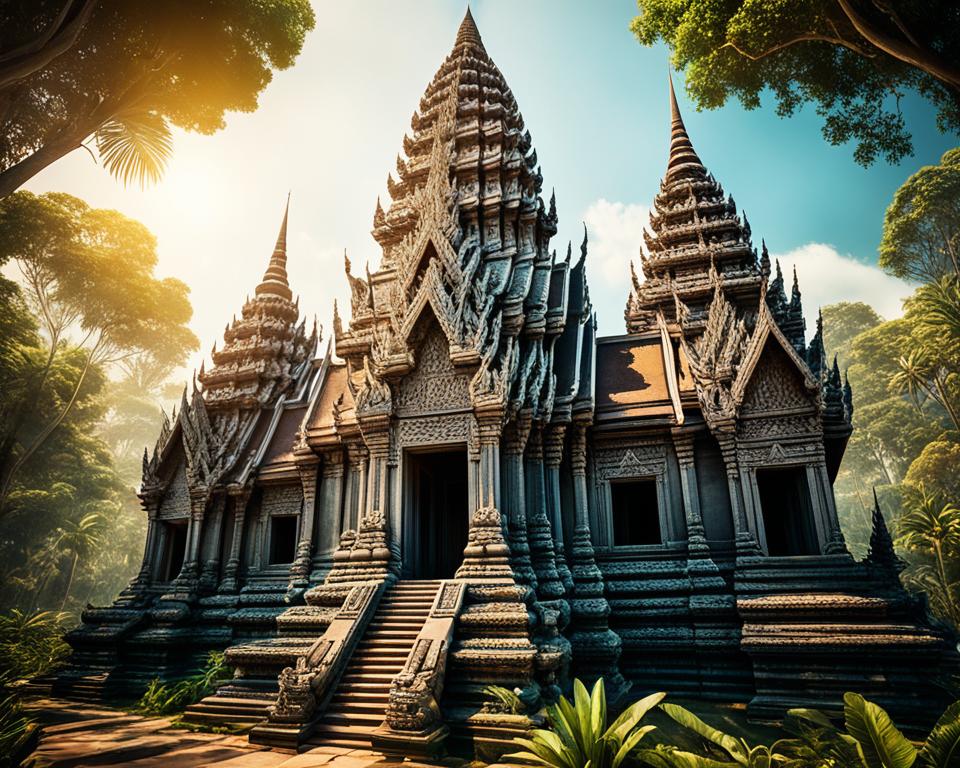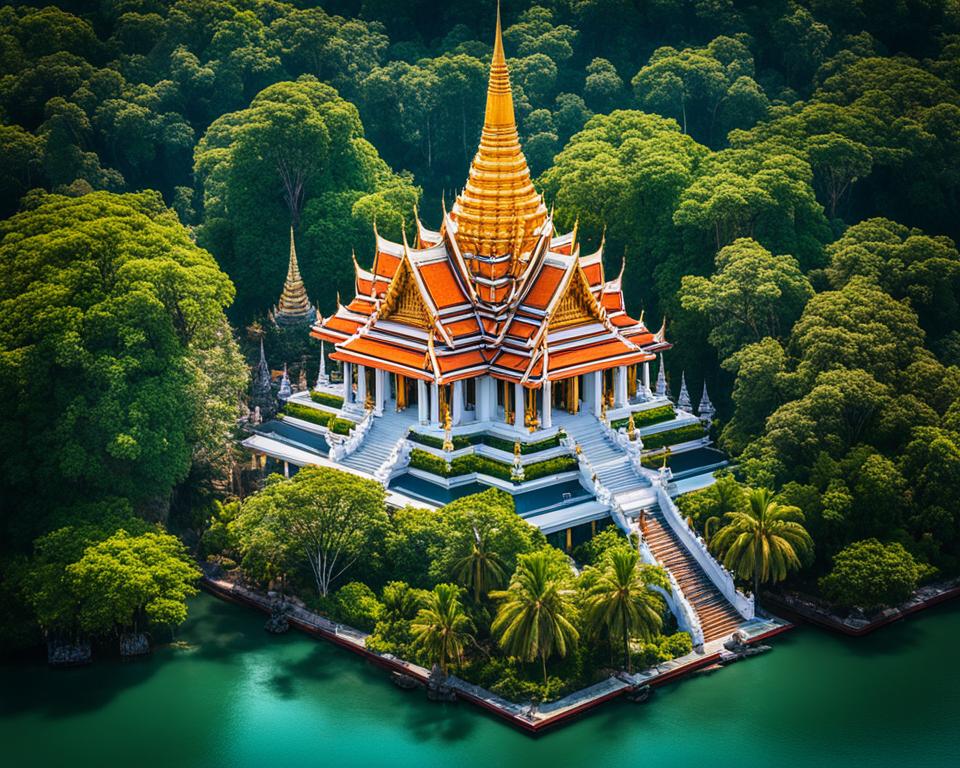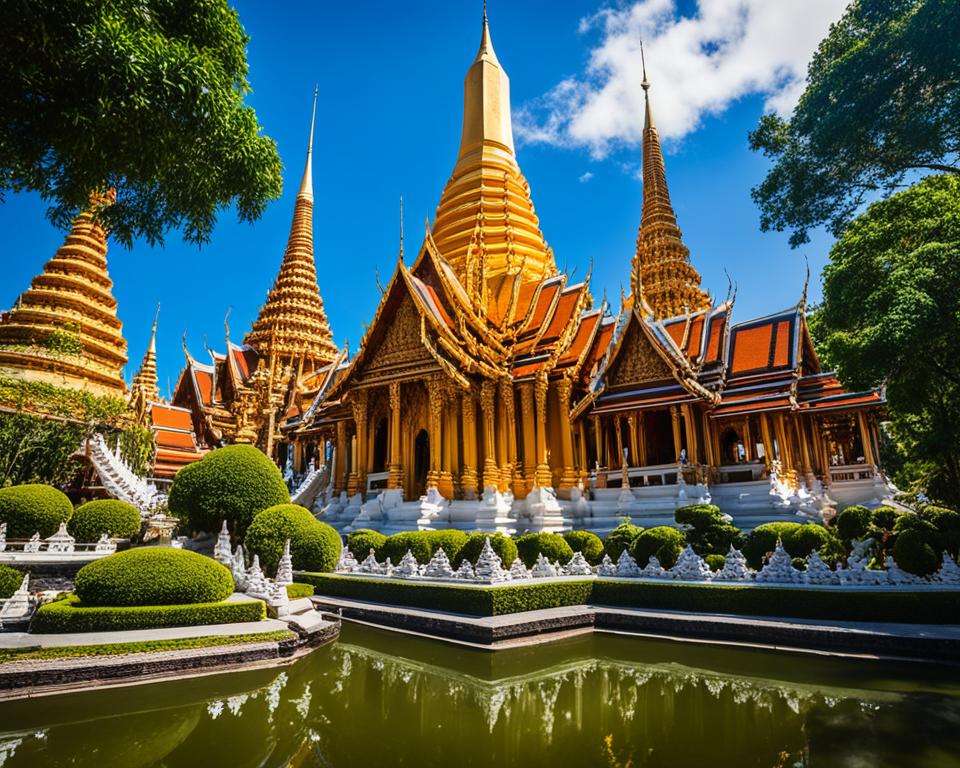Thailand boasts many stunning temples that reflect its rich culture and deep spirituality. Places like Wat Pho in Bangkok and ancient sites in Sukhothai and Ayutthaya draw in visitors. They are famous for their detailed designs, shining tops, and peaceful vibes.
When you visit these holy grounds, you peek into Thai Buddhism’s core and its influence on local architecture. This guide will walk you through Thailand’s top temples, showing their importance and beauty. Get ready for a journey through Thailand’s timeless spiritual and artistic gems.
Read more interesting information at ::infosavjetnik
The Enchanting World of Beautiful Temples in Thailand
Thailand’s temples are more than stunning buildings. They hold deep meaning in Thai culture and spirituality. These special places bring together Buddhism, history, and art. They help visitors from all over understand Thai beliefs and traditions.
Exploring Thailand’s Rich Cultural Heritage
Wat Arun‘s tall spires and Ayutthaya‘s detailed carvings showcase special styles. They mix to show Thailand’s diverse history and artistry. Travelers can deeply connect with Thailand’s spirituality by exploring these temples.
Architectural Marvels Steeped in Spirituality
The temples in Thailand are living symbols of its strong Buddhist faith. They highlight the country’s amazing art and design. These places, with their detailed carvings and peaceful settings, leave a lasting impression on visitors.
Wat Pho: The Birthplace of Thai Massage
Wat Pho is in the heart of Bangkok, known as temple complexes in Thailand. It’s famous for being the start of traditional Thai massage. People see it as a sacred place that shows the best of Thailand’s culture and art. It has also kept alive the ancient practice of Thai bodywork.
The Reclining Buddha: A Monumental Masterpiece
The temple’s big draw is the Reclining Buddha. It’s a 46-meter-long statue showing the Buddha relaxing. This statue is adorned with mother-of-pearl and shows the best of Thai Buddhist art. It’s a symbol of the country’s detailed craft and spirituality.
Discovering the Art of Traditional Thai Massage
Wat Pho is famous for more than its statue. It’s also a key place for learning about ancient art of Thai massage. The temple has a school that has taught massage for a long time.
Visitors can see the stunning architecture, take part in Buddhist rituals, and get a massage. This lets them experience the rich history of the temple.
Wat Arun: The Temple of Dawn
Wat Arun stands by the Chao Phraya River, ranking among Thailand’s top temples. It’s nicknamed the Temple of Dawn. The temple’s look comes from its tall, detailed spires covered in porcelain, seashells, and ceramics. This Khmer-style design features high, detailed towers, showing the Khmer Empire’s impact on Thai architecture.
A Riverside Marvel of Khmer Architecture
People can climb the central tower for stunning views of the river and city. It’s an experience you won’t forget.
Wat Phra Kaew: The Grand Palace’s Emerald Buddha Temple
Wat Phra Kaew is situated within the Grand Palace in Bangkok. It houses the Emerald Buddha, a crucial Buddhist relic. This tiny statue, made from a single jade block, is the heart of many Buddhist temples in Thailand. It’s deeply respected by the Thai people.
The Revered Emerald Buddha: A National Treasure
At Wat Phra Kaew, tourists can see a special ceremony. It’s about changing the Emerald Buddha’s clothes. This shows how much the Thai people and their royals honor their faith and history.
Exploring the Grandeur of Thai Royalty
Besides the Emerald Buddha, Wat Phra Kaew offers more. It shows off with grand Thai temple architecture. This lets you see the richness and authority of the Thai kings over time.
Sukhothai Historical Park: A UNESCO World Heritage Site
The Sukhothai Historical Park is in northern Thailand. It’s a UNESCO World Heritage Site. The site preserves the ruins of the Sukhothai Kingdom, the first independent state in Thailand.
This open-air museum boasts well-preserved ruins. These include temples, pagodas, and statues of Buddha. They highlight the Sukhothai era’s architectural and artistic brilliance, known as Thailand’s golden age.
Unveiling the Splendor of Ancient Siam
Walking through the park, visitors will see stunning stone carvings and statues. They show the greatness of the ancient Thai kingdom. The ruins provide a look into the Sukhothai period, where art and spirituality thrived.
Exploring the Roots of Thai Buddhist Architecture
The park is a treasure for those wanting to learn about Thai Buddhist architecture. It shows how it has influenced Thailand’s cultural identity over the years. The various temples and statues at the site highlight the special mix of styles and influences of that time.
Exploring the Sukhothai Historical Park helps visitors better understand Thai temple design. It’s a key part of Thailand’s cultural heritage, reflecting the country’s rich history.
Ayutthaya: The Ruins of an Ancient Capital
Ayutthaya, the old capital of Siam, is famous for its old temples and palaces. They show us how rich and powerful Siam was during its best times. A key place to visit in Ayutthaya is Wat Chaiwatthanaram. This beautiful temple mixes Khmer and Thai styles in a unique way.
Wat Chaiwatthanaram: A Masterpiece of Khmer Architecture
Wat Chaiwatthanaram stands out with its high spire and detailed carvings. The temple’s Khmer style is clear in its fine stone work and big size. This shows how the Khmer and Thai cultures inspired each other.
Discovering the Legacy of Siam’s Golden Age
In Ayutthaya, you can see the remains of temples and palaces that date back to the Ayutthaya period. This was a time of great wealth and art in Siam, now Thailand. The Buddhist temples here are symbols of Thailand’s rich culture.
Beautiful Temples in Thailand: A Journey Through Time
The temples of Thailand show a mix of styles and influences over the years. For example, Wat Pho in Bangkok and the ancient Sukhothai and Ayutthaya ruins. Each place has its own design and spiritual meaning.
Exploring the Diversity of Thai Temple Architecture
At Wat Arun, you’ll see tall spires inspired by the Khmer. In Sukhothai, there are detailed carvings and Buddha statues. You can also see Buddhist customs at the Grand Palace’s Wat Phra Kaew. This variety helps travelers understand Thailand’s deep culture and the impact of Buddhism.
Unveiling the Artistic and Spiritual Significance
Thai temples are not only about the architecture. They are also centers for spiritual acts and tradition. People can see Buddhist customs and understand the temples’ role in culture. Things like daily offerings and ceremonial robe changes for the Emerald Buddha show this.
The Art of Thai Temple Murals
Many Thai temples display stunning murals. They show Buddhist tales, local stories, and Thai life. These lively paintings, in the famous Thai style, share cultural insights. They tell of spiritual beliefs, social norms, and art.
Exploring the temple murals lets visitors uncover their deep meanings. They tell stories and myths through bright pictures. Understanding these murals helps travelers see the beauty of Thai culture. It shows the important connection between temples and Thai artistic and spiritual traditions.
Decoding the Stories Depicted in Vibrant Colors
Thai temple murals are not just for looks. They represent Thailand’s deep culture and beliefs. By looking closely, visitors can learn about stories, legends, and Buddhist lessons.
These murals illustrate the Buddha’s life, local stories, and daily life. They are like an Thai culture encyclopedia. They show how Buddhist temples influence Thai art and spiritual beliefs.
Khmer Architecture in Thailand: A Lasting Legacy
The Khmer Empire’s impact is clear in many of Thailand’s top temples. Iconic places such as Wat Arun and Wat Chaiwatthanaram show off this style. They have tall, detailed prangs (spires) and beautiful stone carvings. This shows how the Khmer culture influenced Thai temple architecture a long time ago. These temples tell a story of cultural sharing that has gone on for centuries.
Exploring the Influence of the Khmer Empire
Visitors to Khmer-influenced temples in Thailand can learn a lot. They can see the shared history and art styles that make up Thailand’s culture. Thai temple design includes Khmer details like tall prangs and detailed carvings. This shows how much these two cultures have learned from each other.
Marveling at the Intricate Stone Carvings
The stone carvings in Khmer architecture of Thailand are a must-see. They include stories of myth and beautiful nature designs. These carvings are a display of Khmer artists’ skills and creativity. When visitors see these carvings up close, they understand the deep culture and art connections of the area.

Buddhist Rituals and Traditions in Thai Temples
Thailand’s temples are not just stunning buildings. They are also alive with spiritual acts and old customs. Buddhist temples in Thailand will show anyone the respect seen in Buddhist practices. These include giving flowers, incense, and candles each day. Also, they chant ancient texts and change special robes for the Emerald Buddha at Wat Phra Kaew.
Experiencing the Serene Atmosphere of Spiritual Practice
Travelers can understand Buddhism’s deep influence by being at Thai temple architecture. The peaceful and reflective vibes offer insight into Thai culture. It tells the story of spiritual practices that have lasted for so long in these sacred places.
The Significance of Wats in Thai Culture
In Thailand, a “wat” means a Buddhist temple. These places are key in Thai life. They bring the community together for religious events, fun, and social occasions. Buddhist temples in Thailand host colorful events, including Songkran and Loy Krathong, a festival for the goddess of water.
Understanding the Role of Temples in Daily Life
Wats are at the heart of daily life for Thais. They are important for both their beauty and spiritual function. This understanding helps visitors see the deep connection between Thai temple architecture, culture, and traditions.
Exploring the Art of Thai Temple Festivals
Thai temples are more than places to worship. They are where cultural and community events happen. These events celebrate tradition and honor Buddhism. Here, visitors can enjoy music, dance, and rituals that make up the local culture.
Sustainable Tourism and Preserving Thai Temples
Thailand’s temples are growing in popularity. It’s key to practice sustainable and responsible tourism. This ensures the iconic temples are saved for those who come after us. Visitors must respect the sacred sites, follow local customs, and back conservation efforts with their choices.
Responsible Travel for a Better Tomorrow
Being mindful when visiting Thai temples is important. It helps protect these important places. It also aids in the sustainable growth of Thailand’s tourism sector. Responsible visitors help in preserving the beauty and value of these places for the future.
Travelers should think about their impact on the environment. They should also support the people who live around the temples. Conservation work is also crucial. By traveling responsibly, tourists can have a meaningful impact on saving these sites. This ensures they are enjoyed by many for years to come.

Planning Your Temple Tour in Thailand
When in Thailand, a temple tour needs careful planning for a special journey. The ideal time to visit is from November to February. This period sees cooler weather and fewer tourists.
Exploring temples in this season is great. Visitors can feel the spiritual calm and see amazing architecture. The lack of intense heat makes the experience more comfortable.
Essential Tips for Respectful Temple Visits
Visiting Buddhist temples in Thailand means dressing modestly and taking off shoes. Knowing and respecting local customs is also vital. This includes how to behave in these sacred places.
The temples are part of Thailand’s rich cultural heritage. By appreciating and respecting these sites, visitors can learn a lot. This experience can deepen their connection to Thailand’s culture and spirituality.
